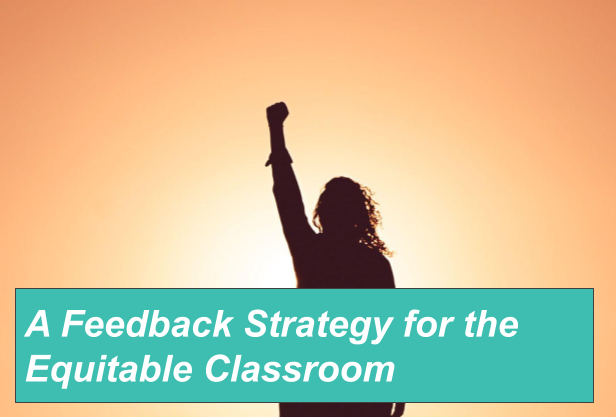A Feedback Strategy for the Equitable Classroom

In a recent blog post, we mentioned that when our students feel a low sense of belonging in our classrooms they are far more likely to attribute positive feedback to external causes and critique to internal causes, engaging in self-blame. In the same blog post, we wrote that giving encouraging written feedback is one way to mitigate this problem while also increasing our students’ feelings of belonging.
Today, I’d like to share a strategy that takes this kind of feedback one step further: the Power Response.
What is a Power Response?
A Power Response is when a teacher gives feedback to students about their work via audio or video recording in place of written feedback. I first heard of Power Responses from a band teacher, Mark Wells, who uses Power Responses for student playing tests (this is when band teachers evaluate students playing their instruments individually).1 His students record themselves playing a few measures of music, then Mr. Wells creates a Power Response by screen recording himself as he listens to their recording. He gives his feedback orally while listening - “Oh, good crescendo!” “Don’t forget the slurs!” so that his students can watch on their own and receive what amounts to a mini private lesson.
Giving feedback with our voice allows us to convey far more nuance than writing or typing can. Students may perceive a mark on their paper very differently than the way we intended. With our voice, we can reassure and encourage them even while critiquing their work.
What does the research say?
Ice and colleagues conducted an interesting study comparing written feedback with audio feedback for students.2 Some of their findings include:
- Audio feedback was perceived to be more effective than text-based feedback for conveying nuance.
- Audio feedback was associated with feelings of increased involvement and enhanced learning community interactions.
- Audio feedback was associated with increased retention of content.
- Audio feedback was associated with the perception that the instructor cared more about the student.
That third point about increased content retention is probably reason enough to try this, but I’d like to highlight the findings that relate to educational equity. Feelings of increased involvement? Enhanced learning community interactions? Perceiving more care from the teacher? Yes, please!
Conclusion? Power Responses from teachers seem to lead to increased feelings of belonging in students.
When our students’ sense of belonging goes up, they are less likely to engage in self-blame when they struggle with class content, and more likely to look to their classmates and teachers for support. In short, when belonging increases, our classrooms become more equitable.3
How does this fit into the math classroom?
As math teachers, it may be difficult for us to find the right fit for a strategy like Power Responses. Many times, our feedback may consist of a symbol of some kind: a plus for correct, slash for incorrect, maybe a worked out problem in the margin to show a different technique. So when might we take the time to record our feedback via audio or video?
Keep in mind that we don’t need to give Power Responses every day for our students to feel its benefits. Consider quizzes or other formative assessments as opportunities to give Power Responses. You might also give Power Responses for exit tickets or homework assignments once or twice per month.
Snap a picture of their work, use one of the many efficient and free audio or video tools out there (I like Mote4 and Screencastify5), and you’re off and running. Or, if you have a document camera, you can place a student’s work under the camera, click record, and write out your feedback as normal while adding your verbal remarks as you go.
No matter which technique you settle on, when students listen to your feedback, they’ll hear your positivity, your care, and your passion for the content. Power Responses can be an effective way to give our students feedback about their work while increasing their feelings of belonging.
Pete Grostic, Ph.D
Executive Director
Please join Math Medic Foundation in our mission to improve math outcomes for all. You can contact us to get involved or donate here.
Follow us on Twitter!
1 Assessment Made Easy - Mark Wells
3 Educational equity is when each child receives what they need to develop to their full academic and social potential - National Equity Project
4 Mote - audio recording Chrome extension
5 Screencastify - screen recording for any device
05/01/2023